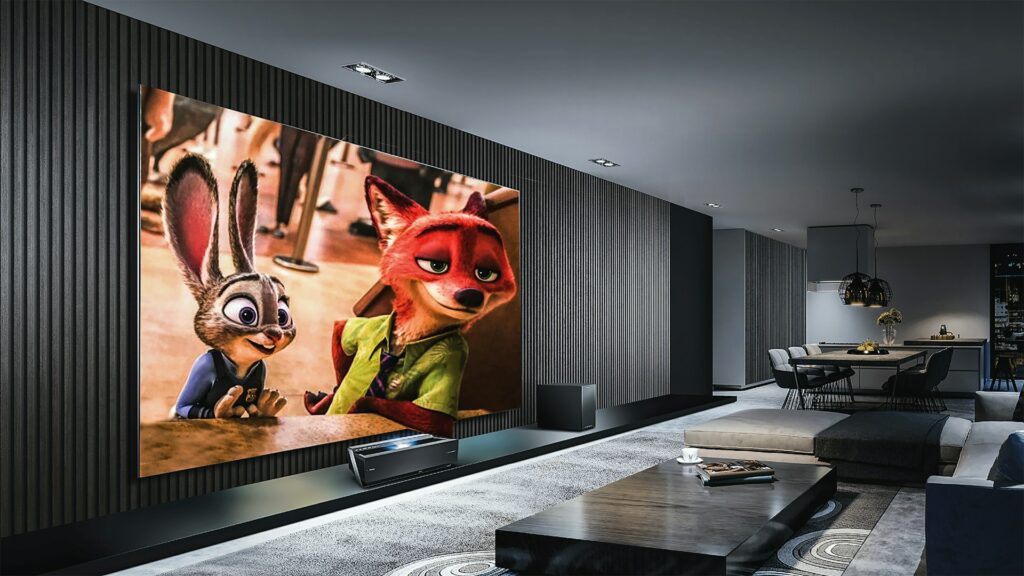Imagine transforming a corner of your home into a sanctuary of cinematic magic. A place where you can lose yourself in the latest blockbuster, cheer for your favourite sports team or binge-watch your favourite series in unrivalled comfort. Designing a home theatre can be a thrilling endeavor, blending creativity with technology to craft an immersive experience.
Choosing the Perfect Spot
The first step in designing a home theatre is selecting the right space. Ideally, this should be a room where you can control lighting and sound. A basement is often a popular choice due to its natural insulation from external noise and light. However, any room can be transformed with the right treatments. Ensure the space is large enough to accommodate your desired screen size and seating arrangements without feeling cramped.
Control the Light
Lighting plays a crucial role in creating an immersive home theatre experience. Too much light can wash out the image on the screen, reducing the impact of the visuals. Invest in blackout curtains or shades to block out any natural light.
For interior lighting, consider dimmable lights or smart lighting systems that you can control with your phone or a remote. You could even add LED strip lights behind the screen or under seats to provide your home theatre with some subtle and non-intrusive illumination.
Invest in Quality Seating
Comfortable seating is necessary in a home theatre. Choose recliners or sectional sofas with plush cushions and armrests. You could even look for seats with built-in cup holders and storage for convenience. If you have the space, consider tiered seating; this ensures that everyone has a clear view of the screen. Leather or high-quality fabric upholstery not only adds a touch of luxury, but it’s also easy to clean and maintain.
Go for a Large Screen
The screen is the centerpiece of your home theatre. Depending on your budget and space, you can choose between a large flat-screen TV or a projector and screen setup. A projector can provide you with a more authentic cinema experience, especially if you go for a 4K model with high brightness and contrast.

Make sure you choose a screen size that’s appropriate for your room size. If it’s too small, it won’t feel immersive; if it’s too large, it could cause eye strain.
Prioritise Sound Quality
Sound is just as important as visuals in a home theatre. You want to invest in a high-quality surround sound system to create an immersive audio experience. Think about a 5.1 or 7.1 system, as these provide multiple speakers around the room, including a subwoofer for deep bass, which makes them ideal. Position the speakers strategically: front speakers at ear level, surround speakers slightly above and behind the listening area with the subwoofer in a corner for best bass distribution. You can also soundproof the room with acoustic panels, heavy curtains, carpets, or luxury vinyl flooring with soundproofing underlay to minimize external noise and enhance audio clarity.
Integrate Smart Technology
You can incorporate smart technology to elevate your home theatre experience. Use smart home devices to control lighting, sound, and even the screen with a single touch or voice command, helping you simplify managing your home theatre. You can even set up routines that dim the lights, lower the screen, and start your film with a single command for a seamless experience.
Pay Attention to Aesthetics
Functionality is always important, but that’s not to mean you can’t make your home theatre look great. You should choose a cohesive colour scheme that complements your home’s décor, while enhancing the cinematic atmosphere.

Think about using darker colours like deep blues, greys or blacks, which can also reduce light reflection. Add posters, framed film stills or themed décor to make the space uniquely yours too. Add some interesting art like 3D textured wall art, posters, framed film stills, or themed décor to make the space uniquely yours too. Art not only adds a modern touch but also helps create a tactile, visually dynamic environment that draws the eye.
Plan for Connectivity
Ensure your home theatre is equipped with the necessary connectivity options. HDMI ports, USB ports, and Wi-Fi are essential for connecting various devices, such as gaming consoles, streaming devices, and sound systems. Invest in high-quality cables and consider cable management solutions, keeping everything organized and clutter-free.
Test and Tweak
Once everything is in place, spend some time testing and tweaking your setup. Adjust the speaker positions, fine-tune the projector or TV setting and test the lighting at various times of the day. You could consider getting professional calibration for your screen and sound system to achieve the best possible performance.
Maintain Your Equipment
You should regularly maintain your home theatre to keep it in tip-top condition. Clean the projector lens or TV screen, dust the speakers and ensure there’s ventilation for all electronic components to prevent any from overheating. Periodically, check for software updates for your smart devices and audio-visual equipment to ensure they’re performing to their full ability.

